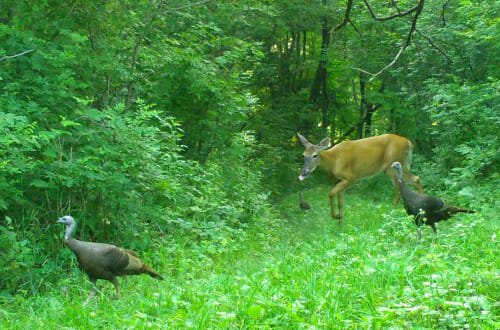When Living Closer To Humans, Animals Encounter Each Other More Often
Human presence and influence on landscapes change the way other animals interact by bringing them close together more frequently than happens in wilder places.
Human presence and influence on landscapes change the way other animals interact by bringing them close together more frequently than happens in wilder places.
Researchers from the University of Wisconsin–Madison used photos from more than 2,000 camera traps in the Wisconsin Department of Natural Resources Snapshot Wisconsin program to determine the proximity in space and time of animals of various species. The time between appearances of different species on cameras was significantly shorter in areas closer to human disturbance, meaning they are likely to interact more often when people are near.
The findings, published today in the Proceedings of the National Academy of Sciences, support the compression hypothesis — the idea that encroaching human activity squeezes the space and time animals share, leaving them closer and more likely to encounter each other. Another school of thought, the expansion hypothesis, predicts fewer interactions as some types of animals (like predators) are disproportionately displaced by people.
 Neil Gilbert
Neil Gilbert
“Compression works like a house party,” says Neil Gilbert, lead author of the study, which he conducted while completing his doctorate in Forest and Wildlife Ecology at UW–Madison this year. “The more people you crowd into a party, the less elbow room you’re going to have and the more likely someone is going to step on your toes.”
While not every species is troubled by human activity — squirrels and deer in particular flourish near people — one thing is clear: Animals who want to avoid human contact must make do with less elbow room.
“We have converted more than 40% of the Earth’s land surface to anthropogenic uses, urbanized landscapes, agricultural landscapes,” says Ben Zuckerberg, study co-author and UW–Madison Forest and Wildlife Ecology professor. “We can think of that as a pretty major form of habitat loss for many species.”
How that loss affects animal behavior and relationships can be hard to study. Tagging individual animals or small groups with tracking devices provides too narrow a view to study community-level interactions. But Snapshot Wisconsin, a community science initiative that recruits volunteers to place camera traps on private and public land, has thousands of sites around the state, producing millions of photos that amount to near-continuous monitoring of animals moving through a wide range of landscapes.
 Jennifer Stenglein
Jennifer Stenglein
“Snapshot Wisconsin supports the DNR’s decision-making, answering important questions about species like elk and deer,” says Jennifer Stenglein, a Snapshot Wisconsin research scientist and study co-author. “But it also can push the envelope on theoretical studies when someone like Neil gets creative with this big dataset.”
Gilbert pulled almost 800,000 photos of animals from the Snapshot Wisconsin archive, assigning each of the nearly 2,000 camera locations a rating for the level of human disturbance within 5 kilometers — plots like those in national forest at the low end and urban development or intense agriculture at the high end — based on NASA satellite imagery.
The researchers also grouped 18 observed species into 74 pairs and sorted them by the likelihood that an encounter turns violent, from low-antagonism pairs like skunks and rabbits to high-antagonism pairs like deer and coyotes. Then they measured the time between appearances at individual camera sites by an animal from each member of a pair.
A deer and two turkeys encounter each other in the woods.
Multi-species interactions caught on camera traps, like this Snapshot Wisconsin image of a low-antagonism pairing of turkeys and deer, are few and far between. So, UW–Madison researchers analyzed the time between species appearances on Snapshot Wisconsin cameras to study the frequency of their interactions near human activity. WISCONSIN DNR/SNAPSHOT WISCONSIN
 Multi-species interactions caught on camera traps, like this Snapshot Wisconsin image of a low-antagonism pairing of turkeys and deer, are few and far between. So, UW–Madison researchers analyzed the time between species appearances on Snapshot Wisconsin cameras to study the frequency of their interactions near human activity. WISCONSIN DNR/SNAPSHOT WISCONSIN “Time separation is our proxy for an encounter,” Gilbert says. “If a camera picks up a squirrel, and then a minute later picks up a coyote, it’s more likely that those two animals are going to interact than if it was like a squirrel and then three weeks later a coyote.”
Multi-species interactions caught on camera traps, like this Snapshot Wisconsin image of a low-antagonism pairing of turkeys and deer, are few and far between. So, UW–Madison researchers analyzed the time between species appearances on Snapshot Wisconsin cameras to study the frequency of their interactions near human activity. WISCONSIN DNR/SNAPSHOT WISCONSIN “Time separation is our proxy for an encounter,” Gilbert says. “If a camera picks up a squirrel, and then a minute later picks up a coyote, it’s more likely that those two animals are going to interact than if it was like a squirrel and then three weeks later a coyote.”
Pairs in the study averaged 6.1 days between camera detections in low-disturbance landscapes, but 4.1 days between detections in high-disturbance landscapes. High-antagonism pairs averaged the most time between detections and low-antagonism pairs the least, but the trend held for each group — the nearer they were to human disturbances, the less time there was between likely interactions.
“This is a big question in ecology: How does human disturbance affect wildlife? We’re clearly seeing it can change their interactions,” Zuckerberg says. “The next questions are about the ramifications. Does it lead to changes in disease transmission? Does it alter predation? Affect things like deer vehicle collisions?”
The researchers hope their work helps people understand the broad impact they have in changing not only animal numbers and habitat size.
“Even if it’s just in terms of the animals in your backyard, your surroundings, your neighborhood, I hope this encourages thinking about our impacts as humans on these invisible dimensions of biodiversity,” Zuckerberg says.
This research was supported by grants from NASA (NNX14AC36G) and to Snapshot Wisconsin by the U.S. Fish and Wildlife Service.
Publication: Gilbert, N., et al. Human disturbance compresses the spatiotemporal niche. PNAS, (2023). DOI:10.1073/pnas.2206339119
Original Story Source: University of Wisconsin-Madison

 Alerts Sign-up
Alerts Sign-up